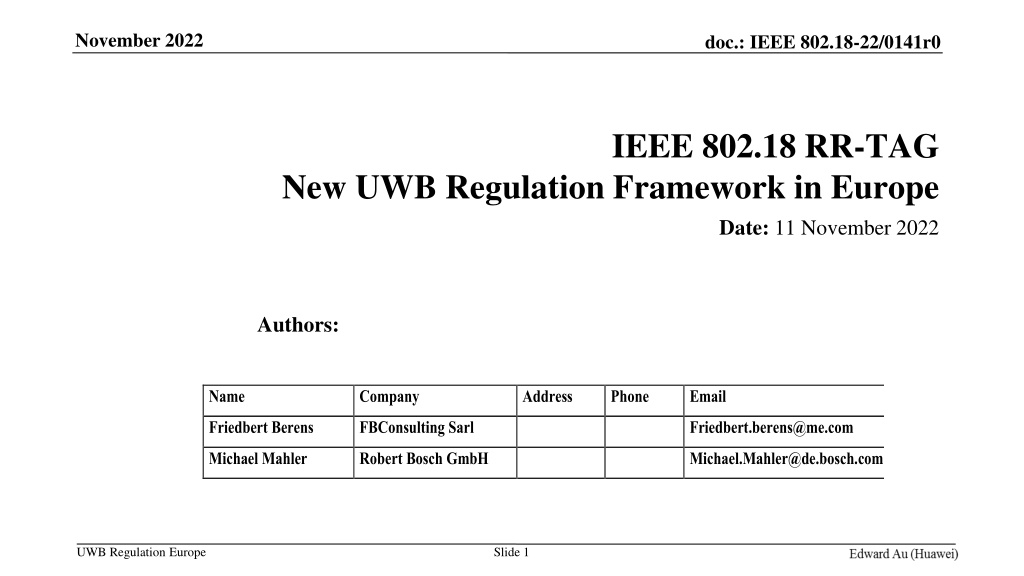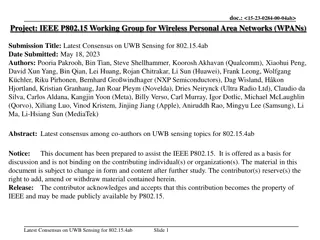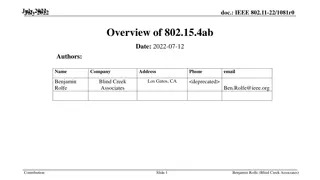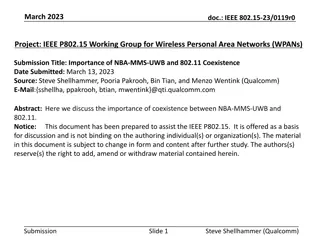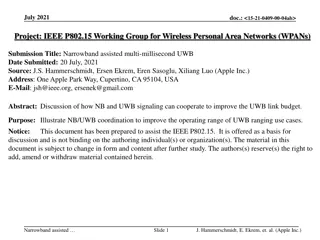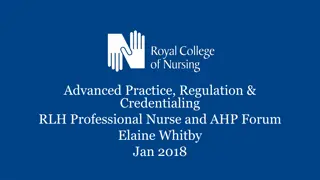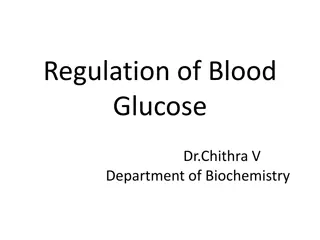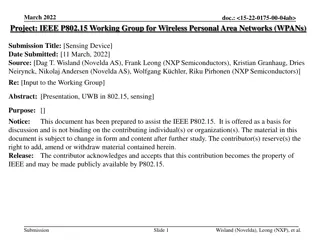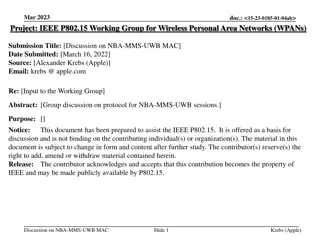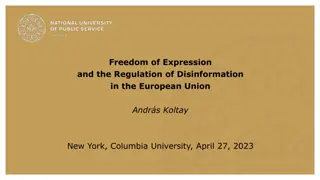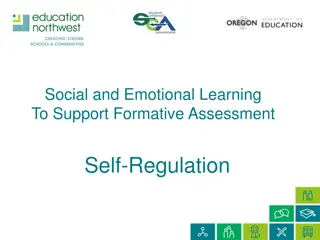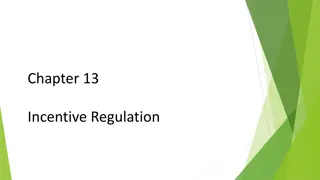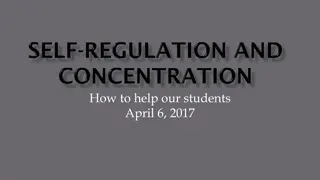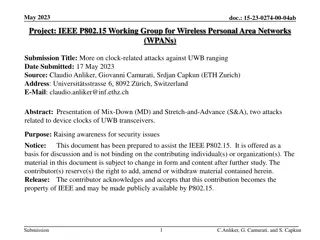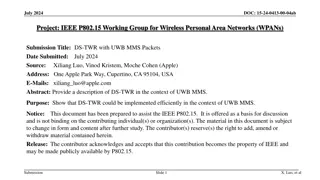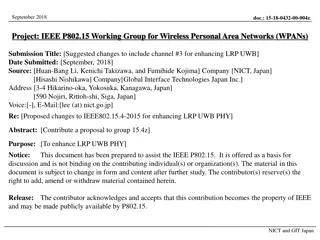New UWB Regulation Framework in Europe
Detailed examination of the new UWB regulation framework in Europe as of November 2022. The document covers UWB emission masks, technical requirements, vehicular applications, and specific access systems. It discusses mitigation strategies, applicability in various scenarios, and new applications involving V2X and V2V communications in the 6.8-5 GHz range.
Download Presentation

Please find below an Image/Link to download the presentation.
The content on the website is provided AS IS for your information and personal use only. It may not be sold, licensed, or shared on other websites without obtaining consent from the author.If you encounter any issues during the download, it is possible that the publisher has removed the file from their server.
You are allowed to download the files provided on this website for personal or commercial use, subject to the condition that they are used lawfully. All files are the property of their respective owners.
The content on the website is provided AS IS for your information and personal use only. It may not be sold, licensed, or shared on other websites without obtaining consent from the author.
E N D
Presentation Transcript
November 2022 doc.: IEEE 802.18-22/0141r0 IEEE 802.18 RR-TAG New UWB Regulation Framework in Europe Date: 11 November 2022 Authors: Name Company Address Phone Email Friedbert Berens FBConsulting Sarl Friedbert.berens@me.com Michael Mahler Robert Bosch GmbH Michael.Mahler@de.bosch.com UWB Regulation Europe Slide 1
November 2022 doc.: IEEE 802.18-22/0141r0 UWB emission masks and related mitigations / requirements for UWB below 10,6 GHz Assessment of ECC/DEC/(06)04 and ECC/DEC/(07)01 11/2022 2 UWB Regulation Europe Friedbert Berens (FBConsulting Sarl)
November 2022 doc.: IEEE 802.18-22/0141r0 General case based on ECC/DEC/(06)04 The technical requirements below are not applicable to: devices and infrastructure used at a fixed outdoor location or connected to a fixed outdoor antenna; devices installed in flying models, aircraft and other aviation; devices installed in road and rail vehicles. 3 UWB Regulation Europe Friedbert Berens (FBConsulting Sarl)
doc.: IEEE 802.18-22/0141r0 ECC/DEC/(06)04, table 1; generic case A1.1 General case for UWB devices Mitigation based on: Note 1: LDC or Note 2: DAA required Mitigation based on Note 2: DAA required UWB Regulation Europe 4 Friedbert Berens (FBConsulting Sarl)
November 2022 doc.: IEEE 802.18-22/0141r0 Vehicular applications based on ECC/DEC/(06)04 5 UWB Regulation Europe Friedbert Berens (FBConsulting Sarl)
doc.: IEEE 802.18-22/0141r0 ECC/DEC/(06)04, table 2; generic vehicle A1.2.1 General case for UWB devices installed in road and rail vehicles Mitigation based on Note 1: LDC + exterior limit or Note 2: DAA + exterior limit or Note 3: TPC + exterior limit required Mitigation based on: Note 1: LDC + exterior limit or Note 2: DAA + exterior limit required UWB Regulation Europe
doc.: IEEE 802.18-22/0141r0 ECC/DEC/(06)04, table 2 generic vehicle without mitigations A1.2.2 Specific vehicular access systems using trigger-before-transmit (table 3) New: A.1.2.3 applications involving V2X and V2V communications in 6 8.5 GHz (table 4) Access systems with Trigger-before-transmit and LDC 0,5% / hr Access systems with Trigger-before-transmit and LDC 0,5% / hr V2X / V2V with installation requirements: antenna height (fixed 10m , vehicle 4m) DC for fixed 5%/s; vehicle 1%/s Note 1: Within the band 6-8.5 GHz, the following additional requirements apply to fixed outdoor installations supporting communication with UWB devices installed in road and rail vehicles: - Antennas are directive (5 dBi or TRPsd requirement out of ECC report 327), down tilted and installed at a maximum height of 10 m; - The duty cycle is limited to maximum 5% per second. Note 2: Within the band 6-8.5 GHz, the following additional requirements apply to UWB devices installed in road and rail vehicles: - Antennas are installed at a maximum height of 4 m; - The duty cycle is limited to maximum 1% per second. UWB Regulation Europe 7 Friedbert Berens (FBConsulting Sarl)
doc.: IEEE 802.18-22/0141r0 November 2022 SPECIFIC RADIODETERMINATION, LOCATION TRACKING, TRACING AND DATA ACQUISITION APPLICATIONS IN 6-8.5 GHz; 8 UWB Regulation Europe Friedbert Berens (FBConsulting Sarl)
doc.: IEEE 802.18-22/0141r0 ECC/DEC/(06)04, table 1 generic case; without mitigations New: A.1.3.1 Specific applications involving fixed outdoor installations (table 5) SPECIFIC RADIODETERMINATION, LOCATION TRACKING, TRACING AND DATA ACQUISITION APPLICATIONS IN 6-8.5 GHZ Fixed outdoor is possible with mitigations - 5%/s (for all heights) - 10m max installation height + antennas down tilted - For heights between 2,5 to 10m a TRPsd of -46,3dBm/MHz required Antennas for data acquisition for authentication/access control (PACS) are excluded from the antenna directivity requirements ETSI has to consider in specific EN or based different device categories UWB Regulation Europe 9 Friedbert Berens (FBConsulting Sarl)
doc.: IEEE 802.18-22/0141r0 ECC/DEC/(06)04, table 1 generic case; without mitigations New: A.1.3.2 Specific applications involving enhanced indoor devices (table 6) Specific RADIODETERMINATION, LOCATION TRACKING, TRACING AND DATA ACQUISITION APPLICATIONS in 6-8.5 GHz Enhanced power is possible with mitigations based on NOTE 1 Portables: - 5%/s and - if controlled by an indoor infrastructure Fixed indoor: - 5%/s ETSI has to consider, t.b.d: how to test / solve (e.g. based on EN scope limitation) UWB Regulation Europe Friedbert Berens (FBConsulting Sarl)
November 2022 doc.: IEEE 802.18-22/0141r0 Annex: Sensor UWB Regulation UWB Regulation Europe Slide 11 Friedbert Berens (FBConsulting Sarl)
doc.: IEEE 802.18-22/0141r0 November 2022 Limits for contact based UWB material sensing devices; based on ECC/DEC/(07)01 Contact-based sensors and imaging devices. The UWB transmitter is only switched on when in direct contact with the material under investigation; 12 UWB Regulation Europe Friedbert Berens (FBConsulting Sarl)
doc.: IEEE 802.18-22/0141r0 November 2022 ECC/DEC/(07)01, table 1; Limits for contact based UWB material sensing devices All emissions (e.i.r.p) & mitigations will be tested based on a test scenario reflecting the intended use (EUT in contact with representative material) as specified in the related specific EN Mitigation based on: Note 5: LDC or Note 5*: DAA required for e.i.r.p > 50dBm/MHz 3.1 3.4 GHz: Instead LBT also LDC or DCC (based on generic regulation) would be possible Mitigation based on: Note 5*: DAA based on NOTE 4 For all EUT (independent on implemented mitigation) No fixed outdoor permitted based on NOTE 2 For all EUT (independent on implemented mitigation) Total Radiated Power spectral density below max spectral density 2,5 2,69 2,69 2,7 (+ DC in range of 10%/s; NOTE 3) 4,8 5 (+ DC in range of 10%/s; NOTE 3) 3,4 3,8 GHz (+ DC in range of 10%/s; NOTE 3) Fixed outdoor could be possible under EC/DEC/(06)04, A1.3 SPECIFIC RADIODETERMINATION .. Or < -50dBm/MHz (see former versions of ECC/DEC/(07)01) as justification Mitigation based on NOTE 1 and based on EUT needs LBT in 1,215 1,73 2,5 2,69 2,7 3,4 GHz fixed outdoor possible fixed outdoor possible fixed outdoor possible fixed outdoor possible fixed outdoor possible If mitigations (NOTE 5 or 5*) are implemented NOTE 4 applies No fixed outdoor permitted Fixed outdoor in 3.1 - .48GHz is possible if emissions will be < -50dBm/MHz* (see former version of ECC/DCEC/(07)01 for justification) UWB Regulation Europe Slide 13 Friedbert Berens (FBConsulting Sarl)
doc.: IEEE 802.18-22/0141r0 November 2022 Limits for non-contact based UWB material sensing devices; based on ECC/DEC/(07)01 Non-contact-based sensor and imaging devices. The UWB transmitter is only switched on when in close proximity with the investigated material and the UWB transmitter is directed into the direction of the material under investigation (e.g. manually, by using a proximity sensor or by mechanical design). 14 UWB Regulation Europe Friedbert Berens (FBConsulting Sarl)
doc.: IEEE 802.18-22/0141r0 November 2022 ECC/DEC/(07)01, table 1; Limits for non-contact based UWB material sensing devices All emissions (e.i.r.p) & mitigations will be tested based on a test scenario reflecting the intended use (EUT in contact with representative material) as specified in the related specific EN Mitigation based on: Note 5: LDC or Note 5*: DAA required 3.1 3.4 GHz: Instead LBT also LDC or DCC (based on generic regulation) would be possible Mitigation based on: Note 5*: DAA based on NOTE 2 and NOTE 2* For all EUT (independent on implemented mitigation) Total Radiated Power spectral density below max spectral density 2,5 2,69 2,69 2,7 (+ DC in range of 10%/s; NOTE 3) 4,8 5 (+ DC in range of 10%/s; NOTE 3) 3,4 3,8 GHz (+ DC in range of 10%/s; NOTE 3) NOTE 3 could clash with NOTE 5 for measurement NOTE 5 is over OFR, NOTE 3 is in 3,4 to 3,8GHz EC/DEC/(06)04, A1.3 SPECIFIC RADIODETERMINATION .. and generic surveillance radiodetermination with enhanced power under A.1.3.2 Fixed outdoor could be possible under Mitigation based on NOTE 1 and based on EUT needs LBT in 1,215 1,73 2,5 2,69 2,7 3,4 GHz based on NOTE 4 For all EUT (independent on implemented mitigation) No fixed outdoor permitted fixed outdoo r possibl e fixed outdoor possible fixed outdoor possible fixed outdoor possible fixed outdoor possible If mitigations (NOTE 5 or 5*) are implemented NOTE 4 applies No fixed outdoor permitted Fixed outdoor is possible if emissions will be < -50dBm/MHz* ( see former version of ECC/DCEC/(07)01 UWB Regulation Europe 15 Friedbert Berens (FBConsulting Sarl)
